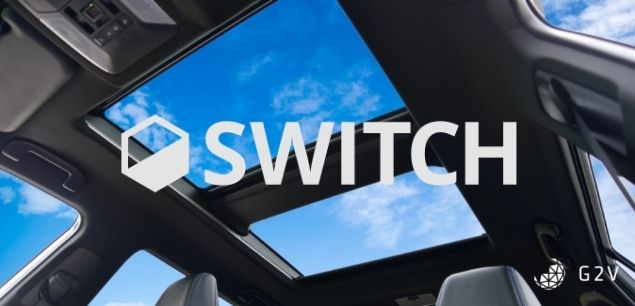Summary
G2V’s solution to meet SWITCH’s needs was a 2 m x 4 m array of Sunbricks. With each Sunbrick measuring 25 cm x 25 cm, this meant an array of 128 Sunbricks, with a few spares to swap in as contingency. Mirrored walls on the outside edges of the array facilitated the achievement of spatial uniformity at the image plane. The arrays were networked together in groups of about 30, and controllable via a Windows-based application.
Enabling Large Area Solar Simulation for SWITCH Materials
SWITCH Materials Inc. develops switchable photochromic-electrochromic technology for integration into applications including automotive glass, architectural glass, and eyewear.
About SWITCH Materials
Innovating Controllable-Tint Glass
Founded in 2007, SWITCH Materials is a Canadian applied-research company with patented materials technology for optically and electrically switchable glass. They’ve worked closely with automotive manufacturers and supply chain partners in their development process.
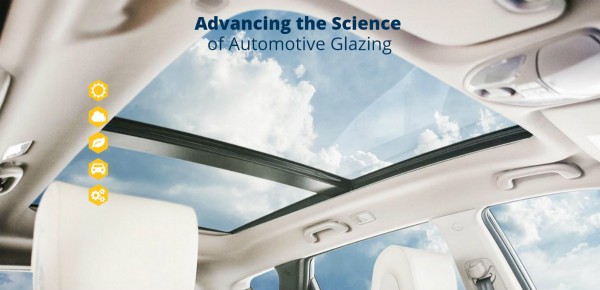
Their photochromic-electrochromic films allow glass to darken automatically under bright-light conditions to reduce heat and glare, and to increase transparency under application of voltage.
The trend toward larger sunroofs in vehicles means that a significant portion of a vehicle’s generated energy goes toward air conditioning. This is the case for gas-powered vehicles (decreasing fuel efficiency by up to 20% [1]) and is even worse for electric vehicles like the Tesla, where the window tint has to be quite dark to maintain a reasonable cabin temperature.
The same trend toward more windows is happening in architecture, with large-window designs that are highly inefficient for insulation. Spectrally-selective windows can reduce the cooling requirements of new homes in hot climates by up to 40% [2]. By being able to control when and how light transmits through glass, SWITCH Materials’ technology promises to reduce global energy consumption in vehicles and buildings.
SWITCH Materials’ Photochromic-Electrochromic films solve growing challenges targeted at the automotive industry but with enough versatility for high relevance in architecture and eyewear.
“Darkly tinted windows help your energy usage by reducing AC use, but car designers and architects also want to bring natural light into the car cabin and buildings. To meet these conflicting design criteria you need a window that can darken when you need to keep heat out, and lighten when you want more natural light.” D. Lam, VP Product Development
Challenges of Innovating Controllable-Tint Glass
Challenge 1
Hard to reproduce test conditions
Being based in Burnaby, BC, where direct sunlight can be hard to come by, especially in winter, SWITCH had to resort to some fairly creative, but costly methods to test all the conditions needed to demonstrate product durability. They had ongoing testing being carried out in Arizona in parallel with their testing in Burnaby. For one test, however, they had to transport product and personnel to a parking lot in Mexico in order to test their film’s response to high-temperature, high-illumination conditions!
Outdoor sunlight is also widely variable, and even more so in the Vancouver metropolitan area. Because SWITCH’s film relies on chemical reactions, its reaction rate and therefore performance is strongly influenced by temperature. Having both uncontrolled light and temperature made qualifying their products a challenge.
While going outside and traveling to different locations was a temporary solution, it ultimately couldn’t provide the comprehensive tests required of automotive products (as specified in ISO 3537:2015 [3] and ANSI/SAE Z26.1-1996[4], for example).
You can’t control the weather, and being forced to travel to all corners of the globe to execute all your testing is not a viable development path.
Challenge 2
Behaviour of actual-scale parts differed from samples
SWITCH had solar chambers, based on xenon arc-lamps, that could control both illumination and temperature, providing a much better solution than travelling to Mexico. However, what quickly became apparent to the team was that the performance of their small samples differed from the performance of actual-scale sunroofs.
While their chambers could test and provide proof-of-concept material validation, they were limited to a size of 0.75 m x 0.6 m.
SWITCH needed a solution that could test the behaviour of full-scale sunroofs.
Challenge 3
Integrated tests not possible with existing technology
High levels of illumination combined with continuously applied electricity was one of the key conditions that SWITCH needed to test their product under. With the knowledge that their product size also impacted results, they now needed a testing facility that could test up to one square meter of product, while simultaneously controlling the temperature and illumination.
Their existing chambers weren’t large enough to accommodate these larger glasses. They had three key parameters they needed to test:
- temperature
- illumination
- sample size
with no way to test all three at once.
Challenge 4
Gas Discharge Lamps Prohibitively Expensive
A solution based on gas discharge lamps (either xenon arc-lamps or metal halides) would have required a very large and costly chamber, because gas discharge lamps by nature emit a great deal of excess heat which has to be heavily managed. If temperature wasn’t a consideration, SWITCH could have just mounted gas discharge lamps in a room, but unfortunately temperature control was a necessity.
“Early on we’d bought a xenon-arc [solar simulator]… it was very expensive for what it was and for how small the spot was… and it was finicky; the power supplies kept going.”
Furthermore, gas discharge lamps require continuous maintenance and bulb replacement about once a year, and for the scale of the system that SWITCH required, would have meant the significant ongoing cost of annually replacing bulbs. The cost of getting a large-scale illumination system in which they could control the temperature was such an impediment that SWITCH did everything it could to avoid getting such a system (like travelling to Mexico!). They couldn’t find workarounds to completely avoid the need for a fully-equipped test solution, however.
Challenge 5
Needed Rapid and Flexible Testing
Finally, SWITCH also needed the ability to rapidly test different material formulations on large-scale glass. The switching speed (from light to dark and vice-versa) was a key parameter for them to optimize, and the ability to get results quickly, reliably and repeatedly would accelerate their development cycles.
Their existing xenon lamps required considerable warmup time in order to generate a reliable solar spectrum, which was taking far too long for rapid development iterations. The lamps’ output was also inconsistent at the best of times, degrading gradually until the bulbs were replaced. Additionally, any required tweak(s) in the spectrum meant swapping out physical filters, which was a time-consuming process SWITCH generally avoided. A key feature they were interested in was the ability to easily test different spectral conditions, because they had customers report significantly different behaviour from the glass under late-afternoon conditions.
“The question was what kind of lights could we use? Initially we looked at metal halide lights; the cost was quite a barrier for quite a while.”
D. Lam, VP Product Development
LED-based Solar Simulator Solution
Sunbrick: Large-area, tileable solar simulator
G2V’s solution to meet SWITCH’s needs was a 2 m x 4 m array of Sunbricks. With each Sunbrick measuring 25 cm x 25 cm, this meant an array of 128 Sunbricks, with a few spares to swap in as contingency. Mirrored walls on the outside edges of the array facilitated the achievement of spatial uniformity at the image plane. The arrays were networked together in groups of about 30, and controllable via a Windows-based application.
Sunbrick: Large-area, tileable solar simulator 
Solution 1
LED Technology: Low-heat, targeted spectrum
Our LED solution offered the possibility of mounting the lights in what was closer to a regular air-conditioned room, rather than necessitating a heavily-insulated chamber. In the final installed 128-brick array, SWITCH was able to adequately temperature control their glass with local heating sources, while managing the ambient room temperature via air conditioning.
The spectral emission of LEDs is also much narrower than xenon lamps. SWITCH’s films only depended on visible wavelengths, so G2V was able to offer a custom solution with a subset of LEDs to target the 400 nm – 700 nm bandwidth the film required. This targeted spectrum meant a reduced number of LEDs which allowed G2V to lower the instrument cost to a more viable price point for SWITCH.
SWITCH was originally nervous about going with an LED-based solar simulator, because LEDs are a relatively new technology compared to the automotive industry’s standard metal halide lamps. The problem of heat management, however, became much more apparent the more they worked with their samples. A metal halide solution simply wouldn’t have been viable for their tests, because temperature was such a vital parameter to control and monitor. Metal halide lamps would have greatly complicated the thermal environment under which the glass was exposed.
“We were able to control [the Sunbrick heat] with fans, and then if we needed additional heat, we would just use heating pads underneath our parts … One of the breaking points in the end was heat… I’m glad we went with LEDs.” Solution 2
Longer LED Lifetime
LEDs have stable outputs rated far longer than gas discharge (xenon or metal-halide) bulbs, with quoted lifetimes (L70) of 50,000 hours [5] whereas metal halide bulbs are rated for 1,000-6,100 hours and xenon arc lamps for 400-3,500 hours [6].
Because LEDs are individually tunable via our software to achieve a target spectrum, the need to replace them after the 5-year mark can be mitigated by a recommissioning visit to gather the data needed to adjust individual LED outputs. In the longer-term case when such an adjustment can’t achieve spectral match, the replacement cost of LEDs is still significantly lower than gas discharge lamps.
This Sunbrick system requires a much smaller ongoing investment to maintain, thereby allowing SWITCH to channel resources to other critical areas of the business.
Solution 3
Sunbrick’s Better Spectral Match
SWITCH Materials had been carrying out short-term characterization under an array of 6400 K fluorescent bulbs, which were cheap and easily replaceable, but were relatively low power and the intensity also varied from bulb to bulb. Additionally, these bulbs were only a very rough approximation of the solar spectrum.
SWITCH required a Class A spectral match solar simulator. G2V delivered a system not only meeting these requirements but exceeding the Class A spectral fit of metal halides, xenon or fluorescent lamps in the wavelength range of interest.
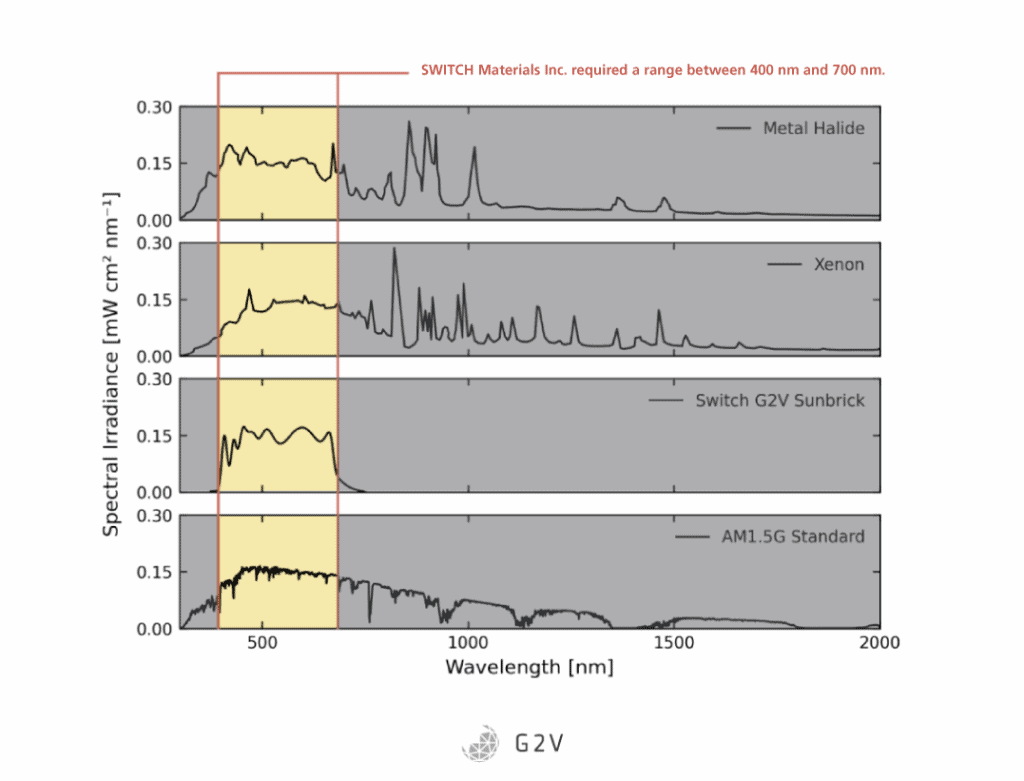
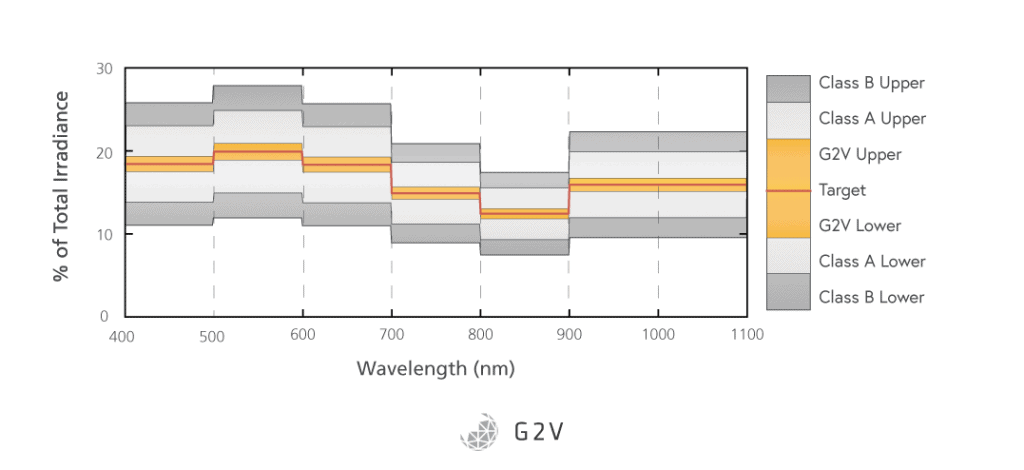
Solution 4
Finely Tunable Spectrum
After the Sunbrick systems had been calibrated, shipped and installed, SWITCH reported a strong material sensitivity to the spectral match in the neighbourhood of 550 nm to 650 nm.
With the Sunbrick’s software-controlled interface and G2V’s guidance, they were able to finely tune the spectral match in this region in order to increase their confidence in the solar simulator’s ability to replicate the specific material response.
This degree of software-controlled spectral tunability was not possible with their existing xenon-based simulators, nor would it have been possible with a metal halide bulb without very costly custom optical filters.
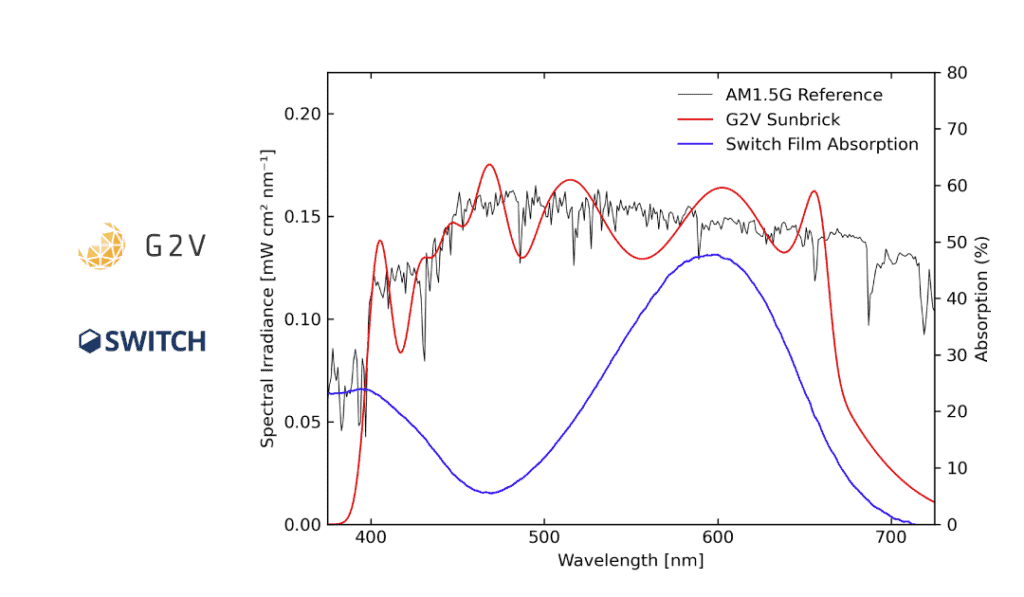
Solution 5
Modularity of Sunbrick Design
The Sunbrick array is constructed in such a way that individual bricks can be removed and replaced should any individual bricks require support or debugging. This means that the likelihood of a system-wide failure is not only lowered, but the impact of a Sunbrick failure is dramatically reduced. Any given Sunbrick’s contribution to the array intensity is small, with the majority coming from neighbouring bricks combined with the mirrored walls on the extremities.
There was a case where a Sunbrick needed to be shut off and serviced, but the 3% decrease in irradiance was still within SWITCH’s test specifications, so they could continue testing while G2V debugged and supported the resolution of system-specific issues.
“We really enjoyed working with the G2V team. They were incredibly responsive and helped to solve problems in a responsible and intelligent manner.”
D. Lam, VP Product Development
G2V Optics Technical Support
Custom projects often require additional support to ensure success. G2V worked closely with SWITCH’s technical staff to respond to any support needs and deliver a high-quality custom solution.
“G2V went over and above to deal with any issues. It’s a very technical topic and G2V obviously knew what they were doing.”
“[G2V] was very good at explaining why things happened and how you had to tune [the Sunbrick]. We always had good conversations [with them].”
“I would totally recommend G2V, if you’re looking for a solar simulator test setup for any light-sensitive materials.”
References
[1] Natural Resources Canada (2018, September). Vehicle air conditioning. Accessed July 29, 2020. Retrieved from https://www.nrcan.gc.ca/energy/efficiency/energy-efficiency-transportation-and-alternative-fuels/choosing-right-vehicle/tips-buying-fuel-efficient-vehicle/factors-affect-fuel-efficiency/vehicle-air-conditioning/21030
[2] Energy.gov Energy Saver (2020, July). Window Types and Technologies. Retrieved from https://www.energy.gov/energysaver/window-types-and-technologies
[3] ISO (2015). ISO 3537:2015: Road vehicles — Safety glazing materials — Mechanical tests. Accessed July 29, 2020. Retrieved from https://www.iso.org/standard/56215.html
[4] ANSI (1996). ANSI/SAE Z26.1-1996: American National Standard For Safety Glazing Motor Vehicles And Motor Vehicle Equipment Operating On Land Highways. Accessed July 29, 2020. Retrieved from https://webstore.ansi.org/Standards/SAE/ANSISAEZ261996
[5] Kusuma, P., Pattison, P. M., & Bugbee, B. (2020). From physics to fixtures to food: current and potential LED efficacy. Horticulture Research, 7(1). https://doi.org/10.1038/s41438-020-0283-7
[6] Tawfik, M., Tonnellier, X., & Sansom, C. (2018). Light source selection for a solar simulator for thermal applications: A review. Renewable and Sustainable Energy Reviews, 90(April), 802–813. https://doi.org/10.1016/j.rser.2018.03.059
Find out more about SWITCH Materials Inc.
SWITCH Materials Website SWITCH Materials Inc. Sunbrick Solar Simulator
